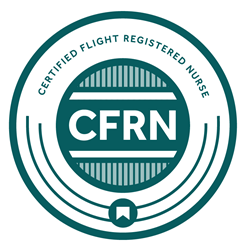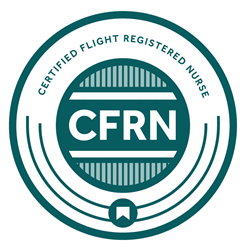
Today, over 5,700 RNs worldwide hold the Certified Flight Registered Nurse (CFRN) credential offered by the Board of Certification for Emergency Nursing.
“Flight nurses must safely provide appropriate, timely, and evidence-based care for patients of all ages in a highly autonomous, dynamic environment.”
OAK BROOK, Ill. (PRWEB)
May 04, 2023
According to a survey of nearly 1,000 registered nurses caring for critically ill or injured patients in the uniquely demanding, complex and high-stakes flight environment, flight nurses earn the Certified Flight Registered Nurse (CFRN) nursing specialty certification “to validate their clinical and patient care excellence, prepare themselves for the flight transport environment, for a competitive hiring advantage, and to lead by example.”
The 2022 Certified Flight Registered Nurse Pulse Survey, whose findings appear in a new, peer-reviewed Air Medical Journal original research article, is the first value of certification study of the CFRN flight nursing specialty credential. The CFRN was introduced by the Board of Certification for Emergency Nursing (BCEN) in July 1993. Today, there are over 5,700 CFRNs worldwide.
To earn the complex and multifaceted CFRN credential, nurses must pass a rigorous exam whose content spans clinical knowledge and professional issues specific to air medical transports, as well as safety, survival, disaster preparedness, scene operations management, communications, and equipment and aircraft knowledge.
“As the air medical transport community prepares to mark a milestone in our commitment to excellence, safety, and advancing patient care with the upcoming 30-year anniversary of flight nursing specialty certification, Air Medical Journal is pleased to present this important research,” said Air Medical Journal co-editor Eric R. Swanson, MD, FACEP, University of Utah School of Medicine, Division of Emergency Medicine, Salt Lake City, Utah.
According to the CFRN-certified nurses who responded to the BCEN survey:
- The top perceived benefits of being a CFRN are a sense of accomplishment and pride (91%), flight physiology knowledge (85%), flight nursing clinical knowledge (83%), and confidence as a flight nurse (81%).
- Since 2012, the annual number of initial CFRN certifications has increased an average of 22%, contributing to a fourfold increase in annual initial CFRN certifications from 2012-2022.
- 35% have over 10 years of flight nursing experience.
- 43% are employed by a stand-alone transport program, and another 25% work for a university/academic hospital or university/academic trauma program.
- 70% of their time is spent in rotor-wing aircraft and 21% in fixed-wing aircraft.
- The majority of their patients (49%) are adults aged 18-65, followed by adults over 65 years old (35%), with smaller percentages of pediatric and neonatal patients.
“Flight nurses must safely provide appropriate, timely, and evidence-based care for patients of all ages in a highly autonomous, dynamic environment,” said article co-author and BCEN CEO Janie Schumaker, MBA, BSN, RN, CEN, CENP, CPHQ, FABC. “CFRN certification independently validates their advanced clinical and operational knowledge across all aspects of flight nursing, and the renewal process provides an invaluable framework to ensure their flight nursing expertise remains current and relevant over time.”
RNs responding to BCEN’s CFRN Pulse Survey in October and November 2022 evaluated the CFRN across 13 value of certification categories and shared nursing career and practice environment demographics, transport mode and patient population types, benefits of CFRN certification during the COVID-19 pandemic, and reasons for earning the CFRN.
Findings from BCEN’s companion survey on certification in the ground transport setting, The 2022 Certified Transport Registered Nurse Survey, appeared in the January/February 2023 issue of Air Medical Journal (available via free access).
“This CFRN certification study, in combination with the recent critical care ground transport companion study, provides important insight into what flight and critical care transport nurses perceive as benefits of advanced certification, and how holding a mode-specific transport credential validates their dedication to safety, professionalism, and patient care excellence in the out-of-hospital environment,” said article co-author Jacqueline C. Stocking, PhD, MBA, MSN, NEA-BC, CMTE, CEN, CFRN, FP-C, CCP-C, RN, NREMT-P, University of California Davis Medical Center, Sacramento, California. Stocking is a long-time editor of Air Medical Journal; her co-editor conducted the editorial process for this article.
About BCEN
Founded in 1980, the independent, not-for-profit Board of Certification for Emergency Nursing (BCEN®) offers robust nursing specialty certification programs fostering empowered nurses across the emergency spectrum who contribute noticeably to patient care, safety and outcomes. Over 59,000 BCEN credentials are held by RNs and advanced practice RNs who specialize in emergency, flight, critical care ground transport, pediatric emergency and trauma nursing. BCEN offers the Certified Emergency Nurse (CEN®), Certified Flight Registered Nurse (CFRN®), Certified Pediatric Emergency Nurse (CPEN®), Certified Transport Registered Nurse (CTRN®) and Trauma Certified Registered Nurse (TCRN®) certification programs.
About Air Medical Journal
Air Medical Journal (AMJ) is the official journal of the five leading air medical transport associations in the United States: the Association of Air Medical Services, Air Medical Physician Association, Air & Surface Transport Nurses Association, National EMS Pilots Association, and International College of Advanced Practice Paramedics. Published by Elsevier, AMJ is the premier provider of information for the medical transport industry, addressing the unique concerns of medical transport physicians, nurses, pilots, paramedics, emergency medical technicians, communication specialists, and program administrators.
# # #

